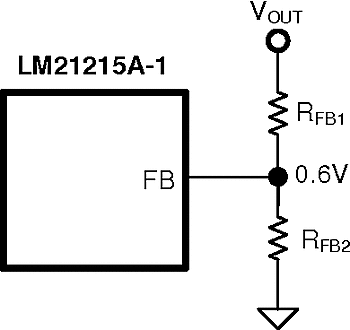SNOSB87D March 2011 – May 2019 LM21215A
PRODUCTION DATA.
- 1 Features
- 2 Applications
- 3 Description
- 4 Revision History
- 5 Pin Configuration and Functions
- 6 Specifications
- 7 Detailed Description
- 8 Application and Implementation
- 9 Power Supply Recommendations
- 10Layout
- 11Device and Documentation Support
- 12Mechanical, Packaging, and Orderable Information
Package Options
Mechanical Data (Package|Pins)
- PWP|20
Thermal pad, mechanical data (Package|Pins)
- PWP|20
Orderable Information
8.2.1.2.2 Output Voltage Setpoint
The first step in designing an LM21215A application is to configure the output voltage setpoint by using a voltage divider between VOUT and AGND, with the middle node connected to FB. When operating under steady state conditions, the LM21215A regulates VOUT such that the FB voltage is driven to 0.6 V.
 Figure 29. Setting the Output Voltage by Feedback Resistor Divider
Figure 29. Setting the Output Voltage by Feedback Resistor Divider A good starting point for the lower feedback resistor, RFB2, is 10 kΩ. Calculate RFB1 using Equation 3.
Equation 3. 
